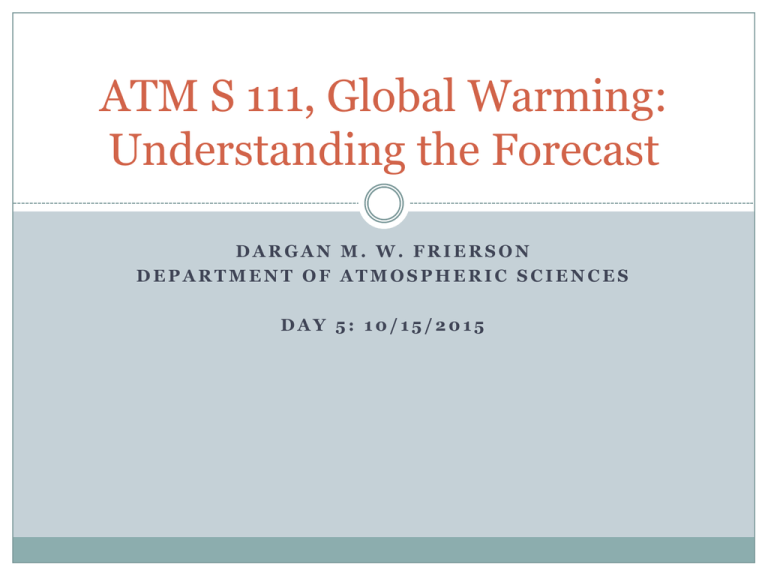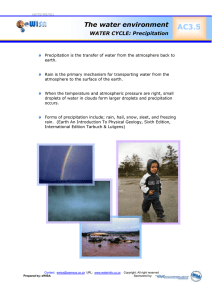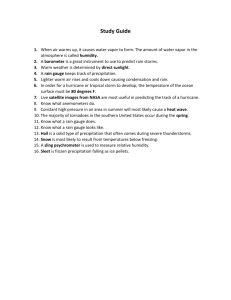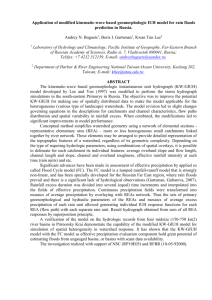ATM S 111, Global Warming: Understanding the Forecast
advertisement

ATM S 111, Global Warming: Understanding the Forecast DARGAN M. W. FRIERSON DEPARTMENT OF ATMOSPHERIC SCIENCES DAY 5: 10/15/2015 Floods and droughts Floods and droughts: two sides of a catastrophic coin A wetter world (but not everywhere) Are floods increasing? Defining drought What do the oceans have to do with drought? The drying of southern Australia The plough and its followers: farming and rainfall Rainiest and Driest Places on Earth These are just places that have weather stations There are likely more extreme places that aren’t being measured Rainiest spot on Earth: Mount Waialeale, Hawaii (pictured): 460 inches/year (11.7 meters) Rainiest spot may actually be Lloro, Colombia: 523.6 inches/year (13.3 meters – this is just an estimated amount though) Rainiest year on record: 905 inches (almost 23 meters) in Cherrapunji, India In the foothills of the Himalayas Rainiest day ever: Reunion Island (500 miles off coast of Madagascar) 72 inches (1.86 m) in 24 hours!!! Also just five years ago, Reunion Island set the record for 72 hour rainfall: 155 inches (3.9 m) during a tropical cyclone Extreme Precipitation All of the above examples are associated with mountains More rain on windward side of mountains When air is lifted up the slope These extremes are localized rainy areas Just like the Olympic Peninsula here in Washington! What’s Required for Rain? To get rain, you need water vapor and rising motion Condensation (water vapor turning to liquid water) happens when moist air cools And this cooling almost always happens with rising motion Let’s take a look at precipitation on a global scale… Outline Precipitation around the world Tropical rainy regions and subtropical deserts Monsoons Storm tracks Changes that are expected in the future Wet areas get wetter, dry regions persist/expand More heavy rain events Changes that have been observed Increased rainfall/floods? Droughts in Australia Droughts in the Sahel Average Precipitation Precipitation (mm/day): Rainiest spots on global scale are narrow bands near the equator Many of the driest places on Earth are over the ocean! Most deserts are around 30 degrees latitude “Hadley Circulation” Air rises above the warmest ocean surface (hot air rises) Sinks around 30 degrees latitude (where deserts are) Michelle Weirathmueller Seasonal March of Tropical Rains Rain shifts northward in Northern summer (JJA), southward in Southern summer (DJF) “Convergence zone”: where winds come together “Inter-tropical convergence zone” (ITCZ): the tropical band. The ITCZ follows the warmest ocean temperatures as they shift with the seasons Rainfall and Vegetation Vegetation follows the seasonal march of rainfall Monsoon Circulations Land heats up in the summer, leads to rising/rain India, Africa, Australia, etc all experience strong monsoons colder hotter El Nino cycles greatly modify the location/intensity of monsoons in IndiaIn& Australia Midlatitude Precipitation Midlatitude precipitation is associated with storm systems Rising motion is generated in particular regions of the storms Take our other classes to learn more! (like ATM S 101) “Storm Tracks” Precipitation (mm/day): Midlatitude precipitation is in storm tracks: preferred locations for storms Seasonal March of Midlatitude Rains Rains shift and change in intensity in midlatitudes seasonally too Notice how close together rainy and dry areas are, in tropics and midlatitudes…. Small shifts in precipitation can cause a massive change locally! Whether rainy regions shift is a key uncertainty for predicting changes with warming January Floods and droughts: two sides of a ST ST catastrophic coinwetter while dry regions become Wet regions become ITCZ drier M ITCZ M SPCZ M SACZ ST M=monsoon, CZ=convergence zone, ST=storm track: Climate models show these features getting stronger with July warming. ST ST M ITCZ SPCZ ST M ITCZ M Climate model projections of precipitation change Wet gets wetter, dry regions expand Stippling: where models agree January July Why? As the atmosphere warms, water vapor concentrations increase Winds bring in even more moisture into the rainy regions W = wind from west T = wind from NE blue = rainbelts Global Warming Rain Responses Wet get wetter More water vapor is brought into the regions that are already rainy Specifically, tropical regions, monsoons, storm tracks, and high latitudes are expected to get rainier Global Warming Rain Responses Dry regions dry/expand Many subtropical regions (in between tropics & midlatitudes) are expected to dry More vapor taken out of dry regions More evaporation from dry land surfaces at higher temperatures Tendency for midlatitude weather to shift poleward and Hadley cell to widen Increased evaporation A warmer atmosphere is like a bigger sponge Sucks up more moisture from the land Simply because warmer air holds more moisture Leads to drier soil in most locations Soil moisture change by 2100 Hadley Cell Widening The Hadley circulation has widened, and this is expected to continue Dry regions expand poleward when the Had. cell widens I was a consultant about Hadley cell expansion for Al Gore’s most recent book The Future Global Warming Rain Responses: Caveat There’s a lot of uncertainty about specific precipitation responses though Regional responses could change significantly due to shifts in rising motion Small shifts can make a big difference for rainfall! Precipitation is much harder to predict than temperature Some Additional Predictions Southwestern North America predicted to dry dramatically As bad as the Dust Bowl by 2060 in some models Dust Bowl drought level Seager et al 2007 US Predictions US predictions How about the most intense storms? The strongest downpours require a lot of water vapor in the atmosphere Warmer temperatures more water vapor Thus, heavy rainfall events should become more extreme Also heavy snowfall events! Are heavy rain events increasing? Very heavy events have been increasing And heavy precipitation events in the US are projected to get worse Are heavy rain events increasing? The global picture on how much heavy rain is increasing Global increase in heavy rain days Locations where heavy rain is changing disproportionally (i.e., not just due to changes in average precipitation) Let’s look at some recent flood events… Nashville, TN, May 2010 A 1000 year flood event (should happen once every 1000 yrs) 2 day rainfall: 13.57” at Nashville airport Country Music Hall of Fame LP Field (home of Titans) Are floods increasing? Extreme flood events should increase with increased heavy rain Trends in the frequency of flood events are difficult to quantify because Rare events, especially when considered season-by-season. it’s difficult to establish statistical significance when dealing with rare events. Hourly rainfall data are available only over limited regions of the globe River configurations and land use are continually changing The first two are true for heat waves too Do forests prevent flooding? A recent study says yes: Bradshaw et al., Global Change Biol. 13, 1-17 (2007) Analyzed broader scale data and found deforestation explained 14% of floods They predict that decreasing forest area by 10% would increase flood frequency 4-28% and duration 4-8% Less runoff, slower erosion when trees are present Defining drought Months or years with below normal water supply. Usually from below average precipitation. The definition is not quantitative. Specific criteria (e.g., how long, how severe...) need to be specified. Other factors such as population growth can create deficiencies in water supply (ie Lake Chad) Shifts in Rain Collapsed the Mayan Civilization? The Mayan civilization was among the most vibrant civilizations in Central America in 250-900 AD They abandoned their southern cities in the 8th & 9th centuries Southward shift of rain band the main cause? The drying of southern Australia Mean Australian Rainfall (mm) 1986 - 1995. 4000 2400 1800 1200 1000 800 600 500 400 300 200 150 100 0 250 Desert The drying of southern Australia Shift in midlatitude storm track southward is important for drying The decline in rainfall in south-western Australia since the 1960s. Source:http://www.ioci.org.au/publications/pdf/IOCI_Notes_Series2.pdf. Drying effects on temperature In most places (as in SE Australia, shown Note that in SW Australia, the drying here) minimum temperatures are rising causes very high maximum temperature rise too. faster than the maximum (greenhouse effect). The drying of southern Australia Other factors that may be playing a role southward shift in the storm track due to the ozone hole increased water demand due to rising temperatures increased water demand due to population growth Recent Droughts in the Middle East Severe droughts in the Middle East peaked around 2010 Four straight years (2006-2010) of drought in northern Syria – worst drought in Syria’s recorded history Precipitation deficit 1970-2010 Water deficit in July 2008 Links to Migration, Uprising? Drought displaced 1.5 million people in Syria by 2011 75% of farmers experienced total crop failure 80% of livestock was lost Many farmers forced to move to cities in extreme poverty A “stressor” for the revolution? Revolts started in March 2011 Clearly many reasons for the revolution, climate is only one Other Arab Spring protests may have been influenced by climate as well Wheat prices were particularly high due to droughts (globally and locally) Recent Drought in Texas Multi-year drought, one of worst in Texas’ history 2011 was worst year Ranchers forced to sell cattle, crops failed Caused higher food prices throughout the country Primarily caused by La Nina But severe La Nina impacts have become 20 times more likely with global warming Dust storm in Lubbock, TX California Drought 71% of the state is at least in “extreme drought” April 2015 snowpack only 5% of normal! Persistent ridge of high pressure has kept rain away while much of US recovered Folsom Reservoir in July 2011 (97% capacity) & January 2014 (17% capacity) California Drought Lake Oroville July 2011 and August 2014 Sacramento and San Joaquin Valleys, Jan ‘13 and ‘14 Three years of above average rainfall needed for recovery The Sahel region of Africa the Sahel SUDAN Darfur The Sahel is in between desert and the region drenched by the African monsoon The African Monsoon in full swing Sahel drought wet period extended drought The shift around 1970 is believed to be due to changing sea surface temperature patterns in the tropical Atlantic (quite possibly driven by aerosol forcing). The disappearance of Lake Chad Lake Chad 1972 1987 Some of My Group’s Research… Dr. Ting Hwang (finished her Ph.D. last year) Studying shifts in tropical precipitation in simulations of 20th century climate Observed versus Modeled Precip Changes Observed precipitation changes for different latitude bands Modeled precipitation changes for different latitude bands Models do a good job at simulating this general drying… Why the Shift? We have found (in previous work) that tropical precipitation shifts towards the warmer hemisphere Even if the warming happens far from the tropics! We find aerosol cooling causes the southward shift in models Aerosols are mostly in the Northern Hemisphere Rain shifts southward, away from the Sahel Pollution Caused Part of the 1980s African Drought? • Our recent study suggests a possible link of the 1980s drought with pollution Shifts are Hard to Predict Shifts in rising motion or midlatitude storms could happen due to: Differences in forcings Differences in feedbacks E.g., aerosols cooling the oceans in places E.g., cloud responses Changes in ocean currents A natural example that messes with rain patterns is El Niño Summary of Floods and Droughts To get rain, you need water vapor and rising motion Hot air rises: this causes rain in the tropics and in monsoons (hot air rising over land in the summer) Where we live (in midlatitudes), rain is associated with storm systems With global warming we will have more water vapor in the atmosphere Warmer air can hold more moisture Hence rainy places get rainier Big downpours will be more intense Many land areas will dry out More evaporation out of the land surfaces Summary of Floods and Droughts Floods and droughts will doubtlessly be some of the most important impacts of global warming Hard to predict exactly though Small shifts in location of rising motion can make a big difference Affected by many things Forcings like aerosols Feedbacks like ice or cloud changes Natural variability like ocean current changes




